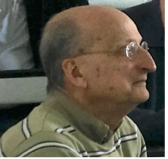Farewell to Ricardo Broglia

Ricardo Broglia passed away in Milan on October 4th. He had been ill for several months.
Ricardo Americo Broglia was born in Cordoba, Argentina in 1939. He trained as a nuclear theoretical physicist at the Institute Balseiro in Bariloche under the guidance of Daniel Bes. Starting from 1965, he then carried out an intense research activity at the Niels Bohr Institute in Copenhagen. At the time the Institute was one of the most important centers in the world for the study of nuclear physics, with a group of theorists and experimentalists led by Aage Bohr and Ben Mottelson, who were awarded the Nobel Prize in Physics in 1975. Broglia joined this group brilliantly, dealing with various aspects of nuclear structure and reactions. He studied collective phenomena, especially those related to surface and pairing vibrations, developing theoretical tools for their investigation, such as nuclear field theory.
In 1985 Broglia joined the Department of Physics of the University of Milan and the Milano INFN Unit. A group studying nuclear structure theory developed around him. They applied many-body theory to the study of nuclear structure and direct nuclear reactions, striving to get a coherent description of the two fields, particularly in the case of loosely bound nuclei. Broglia investigated the link between nuclear and condensed matter superfluidity in an original way, carrying out also a microscopic study of vortices in neutron stars. At the same time, he had a strong interest in the link between theory and experiment, which resulted in a close collaboration with the gamma spectroscopy group, for example for the study of giant resonances at finite temperature. In addition, he collaborated on the EUROBALL project and was a member of the PAC of the INFN laboratories in Legnaro.
His research activity in nuclear physics led to the publication of several monographs of which he was co-author, some of which represent classic references in the field, while the last one was published at the end of 2021.
Broglia had multiple scientific interests, ranging from nuclear physics to astrophysics, from solid state physics to biophysics.
Broglia was a pioneer of nanotechnologies, understanding the fundamental and applicative importance of the study of metal nanoparticles well before most of the international community. Thanks to him, theoretical and experimental activities for the study and characterization of nanoaggregates began in Milan and Italy already in the early 90s. His deep scientific culture, his enthusiasm and his determination have played an essential role in starting new lines of research that have constantly benefited from his support and encouragement.
For many years Broglia has been involved in the physics of proteins. Among other things, he developed the idea of designing molecules that inhibit the activity of harmful proteins by binding and stabilizing disordered conformations, rather than by hitting their active conformation, as conventional inhibitors do. In addition to numerous scientific achievements in this field, he has founded a spin-off with some collaborators to develop antiviral molecules. In all these activities he applied fundamental principles of the physics of many-body systems to systems such as biological molecules that are usually studied from more traditional points of view.
Broglia has taught nuclear structure theory for over 40 years, and was the director of various international schools in Erice and Varenna. Several of his students now work as established researchers. People who discussed with Broglia have always been struck by the way in which he explained the topics that fascinated him. Broglia captivated his listeners, making them feel part of a world of important research. This enthusiasm sustained him right up to the end. In a few months from now, researchers at the Legnaro Laboratories will carry out an experiment stemming from one of his ideas concerning the Josephson effect, on which he kept working until a few weeks ago.